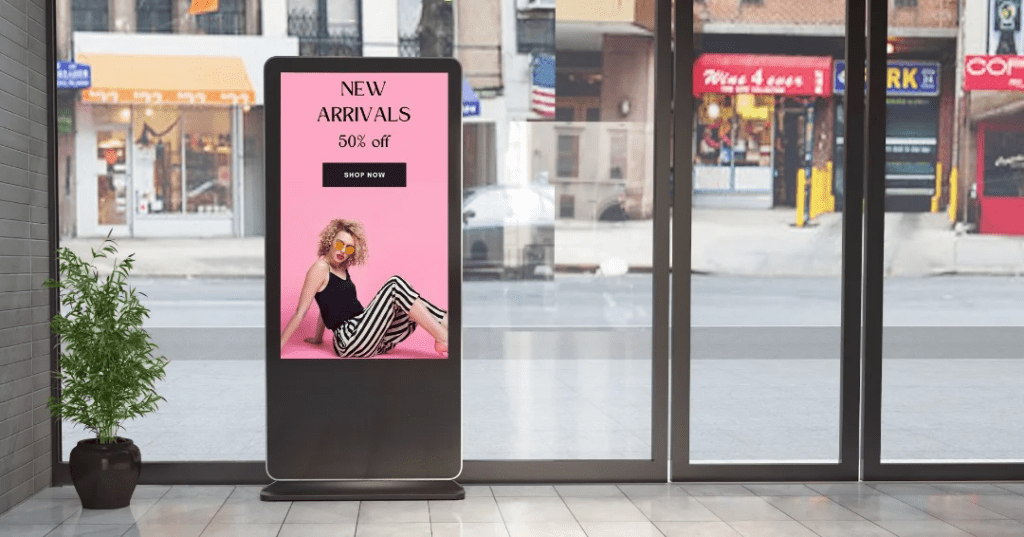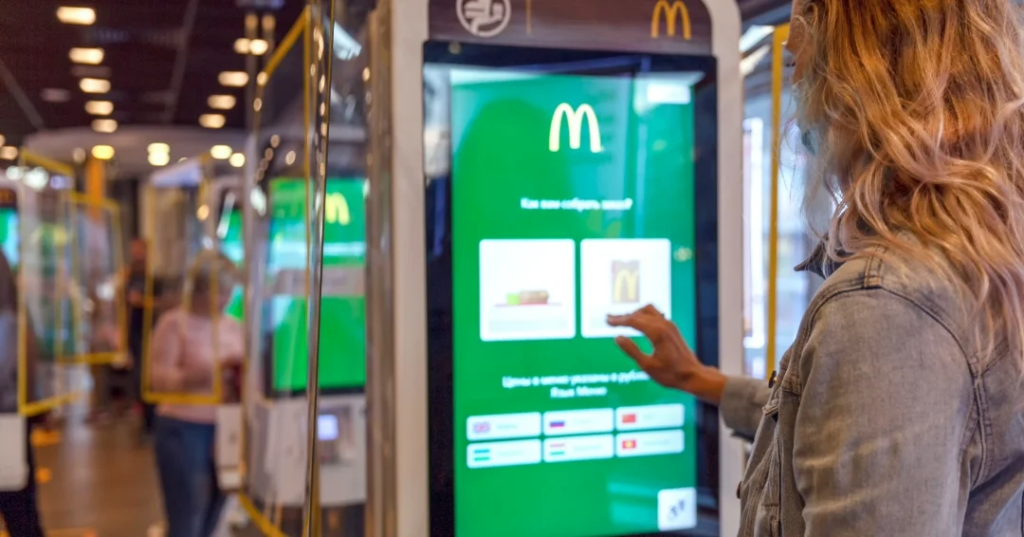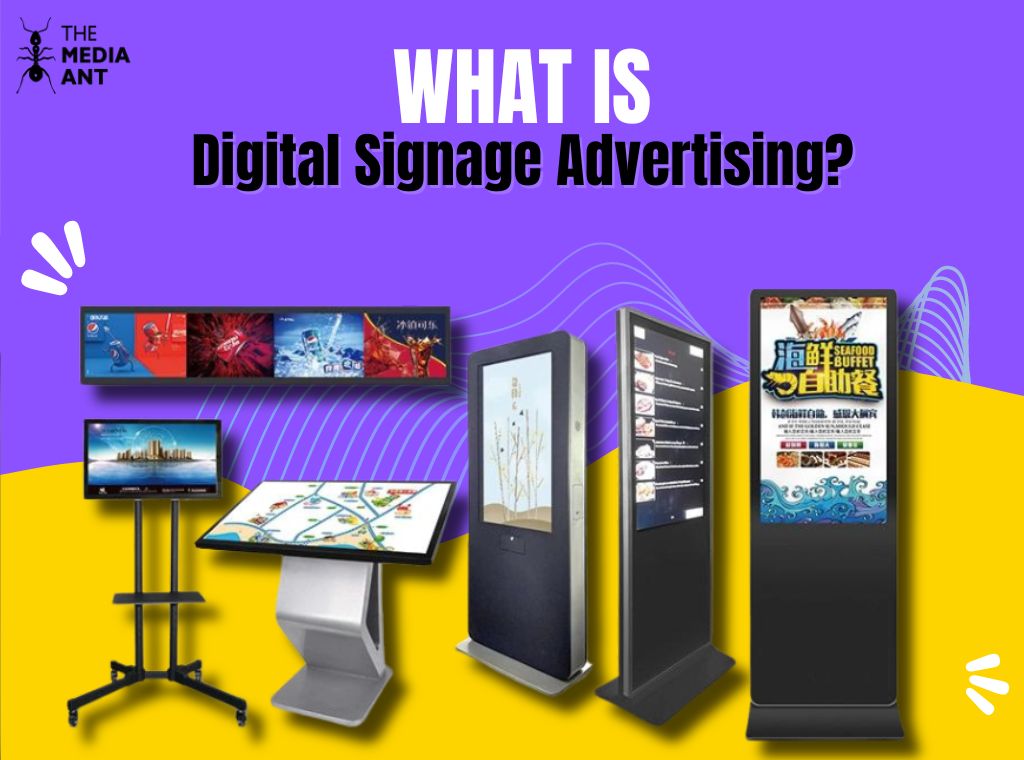In today’s fast-paced digital landscape, capturing the attention of consumers has become increasingly challenging. Enter digital signage advertising – a dynamic and versatile approach that is revolutionizing the way brands connect with consumers.
What is Digital Signage Advertising?
Digital signage advertising is a form of marketing communication that utilizes digital displays, such as LCD, LED, or projection screens, to deliver promotional messages, advertisements, or informational content to a target audience.
Unlike traditional static signage, digital signage allows for dynamic, multimedia content to be displayed, including videos, animations, graphics, text, and interactive elements.
This advertising method leverages technology to create engaging and immersive experiences that capture the attention of viewers in various environments, such as retail stores, restaurants, corporate offices, transportation hubs, sports venues, and public spaces. Digital signage can be deployed as standalone displays, video walls, interactive kiosks, or even integrated into existing infrastructure, providing flexibility and versatility in its implementation.
Advantages of Digital Signage Advertising
Digital signage is effective because it’s engaging and flexible. The bright, dynamic displays capture attention more effectively than static signs. Plus, the ability to update content remotely means you can always keep your message fresh and relevant. Whether you’re a small business owner looking to attract more customers or a large corporation wanting to enhance your brand presence, digital signage offers a versatile solution that can be tailored to your needs.
In a nutshell, digital signage advertising brings the power of digital technology to the world of advertising, making it more interactive, dynamic, and effective at capturing attention and delivering messages.
- Enhanced Engagement: With vibrant visuals and dynamic content, digital signage captures attention and encourages audience interaction, leading to increased engagement and brand recall.
- Targeted Messaging: Leveraging audience analytics and real-time data, marketers can deliver personalized content based on demographics, location, and behavior, ensuring messages resonate with the right audience at the right time.
- Flexibility and Scalability: Digital signage allows for quick and seamless content updates, enabling advertisers to adapt their messaging in response to changing trends, promotions, or events. Additionally, it offers scalability, making it suitable for diverse environments, from retail stores and corporate offices to airports and stadiums.
- Measurable Impact: Unlike traditional advertising methods, digital signage provides robust analytics and metrics, allowing advertisers to track impressions, engagement levels, and conversion rates in real-time. This data-driven approach empowers marketers to optimize their campaigns for maximum effectiveness and ROI.
Real Life Examples of Digital Signage Advertising
Where You’ll See Digital Signage?Digital signage is everywhere! Here are some common places you’ll encounter it:
- Retail Stores: Many retail stores use digital signage to showcase product promotions, advertisements, and in-store events. For example, a clothing retailer might use digital advertising displays to feature seasonal fashion trends, highlight new arrivals, or offer personalized styling tips to shoppers.

- Transportation Hubs: Airports, train stations, and bus terminals often employ digital signage for wayfinding, flight/train/bus information, and advertising. Digital displays can provide real-time updates on departure times, gate numbers, and baggage claim information, while also display advertisements for airlines, travel services, and local attractions.
- Fast Food Restaurants: Quick-service restaurants frequently use digital menu boards to promote menu items, combos, and limited-time offers. Digital signage allows for dynamic content updates and can be programmed to display different menus based on the time of day or customer preferences.

- Corporate Offices: Companies utilize digital signage in their office spaces for internal communications, employee engagement, and brand promotion. Digital displays in lobbies, breakrooms, and meeting areas can showcase company news, upcoming events, employee recognition, and corporate culture initiatives.
- Outdoor Advertising: Digital billboards and street displays are increasingly common in urban areas, highways, and tourist destinations. These high-impact displays showcase advertisements from various brands, promoting products, services, events, and local attractions to pedestrians, commuters, and motorists.
Best Ways to Leverage Digital Signage Advertising
- Content is King: Compelling content lies at the heart of effective digital signage advertising. From captivating visuals to compelling storytelling, focus on creating content that grabs attention and sparks interest. Leverage dynamic graphics, high-quality videos, and personalized messaging to engage viewers and drive desired actions.
- Audience Targeting: Understand your audience deeply and tailor your messaging to resonate with their interests, preferences, and behaviors. Utilize audience analytics and segmentation to deliver personalized content that speaks directly to the needs and aspirations of your target demographic.
- Strategic Placement: Location is key in digital signage advertising. Identify high-traffic areas where your target audience is likely to congregate and strategically position your displays for maximum visibility and impact. Consider factors such as dwell time, viewing angles, and environmental context to optimize the effectiveness of your campaigns.
- Dynamic Content Management: Embrace the agility of digital signage by implementing a robust content management system (CMS) that allows for seamless updates and real-time scheduling. Stay agile and responsive to changing market trends, promotions, and events by leveraging automation and remote management capabilities.
- Measurement and Optimization: Implement a comprehensive measurement framework to track key performance indicators (KPIs) and evaluate the effectiveness of your campaigns. Analyze metrics such as impressions, engagement rates, and conversion rates to gain insights into audience behavior and optimize your strategies for maximum ROI.
FAQs Related to Digital Signage Advertising
How much does digital signage advertising cost?
The cost of digital signage advertising typically ranges from $500 to $5,000 per month, depending on factors such as display size, location, content complexity, and software fees.
What device is used for digital signage?
Digital signage can be powered by various hardware devices, including media players, PCs, laptops, smart TVs, and digital signage controllers. These devices are responsible for displaying multimedia content on digital screens, ranging from standalone displays to large-scale video walls. The choice of device depends on factors such as display size, location, content complexity, and desired features.
What is the future of digital signage?
The future of digital signage lies in increased interactivity, personalized content, seamless integration with IoT, real-time updates, mobile integration, and a focus on environmental sustainability.
Which digital signage is best?
The best digital signage solution depends on specific needs, such as budget, display size, content requirements, and desired features. Some popular options include BrightSign, Samsung SMART Signage, LG webOS Signage, and software platforms like SignageStudio, Xibo, and Scala.
What is another name for digital signage?
Another name for digital signage is “electronic signage” or simply “digital displays.”





